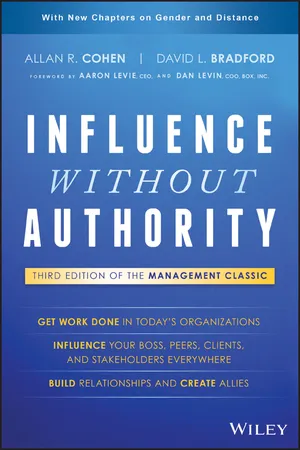
- English
- ePUB (mobile friendly)
- Available on iOS & Android
Influence Without Authority
About this book
Get what you need to achieve your objectives and produce results
Influence Without Authority is the classic guide to getting what you need from people you don't control. Getting things done requires collaboration, and convincing others to contribute requires political skill; this book introduces the Exchange Model, in which you get what you need by offering something of value in return. The key lies in knowing what the other person values—that's their "currency, " and it's your immediate tool for coaxing their cooperation. This model has been proven over decades, as organizations around the world have turned away from frustration and resignation toward collaboration and results. This book shows you how to implement the Exchange Model at the personal, team, and organizational level to raise the bar for performance and leadership.
This new third edition has been updated reflect the changing face of the workplace, and includes new examples and information on geographically dispersed virtual teams. Supplementary materials facilitate classroom and training use with discussions, role-play, videos, and other ancillaries that deepen understanding and promote practical application.
- Get what you need from the people who have it through mutual exchange
- Think in terms of interest, and pinpoint the "currencies" other people trade in
- Apply the Exchange Model across entire organizations to lead major change
- Learn practical real-world strategies for influencing those you do not control
The ability to influence those not under your authority is becoming ever more valuable. Organizations are flattening, and outside contractors are taking on larger roles than ever before—getting results now means lateral cooperation, often across borders, time zones, organizations, and more. Influence Without Authority provides a proven model for success in this new environment, with expert guidance for real-world application.
Frequently asked questions
- Essential is ideal for learners and professionals who enjoy exploring a wide range of subjects. Access the Essential Library with 800,000+ trusted titles and best-sellers across business, personal growth, and the humanities. Includes unlimited reading time and Standard Read Aloud voice.
- Complete: Perfect for advanced learners and researchers needing full, unrestricted access. Unlock 1.4M+ books across hundreds of subjects, including academic and specialized titles. The Complete Plan also includes advanced features like Premium Read Aloud and Research Assistant.
Please note we cannot support devices running on iOS 13 and Android 7 or earlier. Learn more about using the app.
Information
Part I
Introduction
Chapter 1
Why Influence: What You Will Get from This Book

Influence is one of the hottest topics with all of my clients—how can I have more, how can I develop more in my team, how can I be more effective with influence efforts? So much work today is cross team, cross function, project oriented where the leader and the person accountable rarely has formal authority. If you do, and you use your formal authority, it doesn't tend to go well.—Wanda Wallace, President and CEO, Leadership Forum; VoiceAmerica Talk Radio, Host of “Out of the Comfort Zone”
| Increasingly rapid technological change and shortened product cycles; more competition (including internationally) Complex problems requiring smarter employees, more input from specialists, and more integration, making it difficult to command excellence Increased workforce diversity creating more differences about what is important and less automatic agreement Greater geographic dispersal, including language and distance impediments More information needed from a greater number of people Less organizational slack from downsizing and cost-cutting, so more use of all employees needed Greater emphasis on quality and service, so “getting by” doesn't get by Fewer traditional hierarchies, more lateral organizations, including product-based, geographical, customer-focused, matrix, virtual, and networked organizations |
Sachin Bhat Is Asked to Step In
Until then our platform team was not involved with the execution of this project due to other obligations. My first two weeks into the project was to understand the reason for failure from different perspectives—I interviewed product folks, engineers, project managers, marketing managers, program managers, and engineering managers. Because I wanted to understand the product and people, I was carefully observing the dynamics between people and quickly wanted to understand the “currencies” that I could trade with all of them.I spent two weeks talking to every single person, lowest to highest. All were good at pinpointing everyone else's issue. I wanted to understand power, who could influence the power holder, and be sure not to step ...
Table of contents
- Cover
- Title Page
- Copyright
- Dedication
- Foreword
- Acknowledgments
- Part I: Introduction
- Part II: The Influence Model
- Part III: Practical Applications of Influence
- Appendix A: Extended Case Examples and Supplementary Material Available on the Web
- Appendix B: Additional Resources
- Index
- End User License Agreement